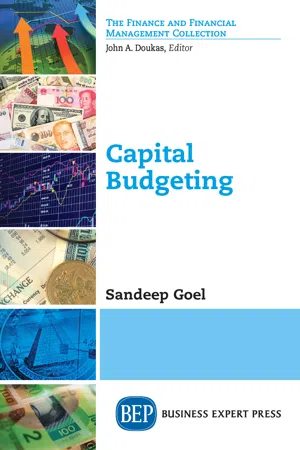Business
International Cost of Capital
International Cost of Capital refers to the required rate of return that investors expect to receive on an investment in a foreign market. It takes into account the risks associated with investing in different countries, such as political instability, exchange rate fluctuations, and regulatory differences. Calculating the international cost of capital is essential for businesses making cross-border investments or seeking international financing.
Written by Perlego with AI-assistance
Related key terms
5 Key excerpts on "International Cost of Capital"
- eBook - ePub
- Sandeep Goel(Author)
- 2015(Publication Date)
- Business Expert Press(Publisher)
SECTION 5 International PerspectivePassage contains an image CHAPTER 12 Capital Budgeting for the Multinational Firms
The Present Chapter It discusses the capital investment practices at the international level.IntroductionForeign-exchange rates, interest rates, and inflation are three external factors that affect multinational companies (MNCs) and their markets. They are particularly useful for evaluating international capital budgeting decisions. Foreign-exchange rates have the most significant effect on the capital budgeting process. A foreign investment project will be affected by exchange rate fluctuations during the life of the project. But, these fluctuations are difficult to forecast. Therefore, correct hedging methods need to be used to incorporate these changes. The cost of capital is used as a cut-off point to accept or reject a proposed project. Since, the cost of capital is the weighted average cost of debt and equity; interest rates also play a key role in a capital expenditure analysis. Most components of project cash flows—revenues, variable costs, and fixed costs—rise in line with inflation. Hence, a capital expenditure analysis requires price projections for the entire life of the project.The investment decision in a foreign country is the outcome of combination of strategic, behavioral and economic considerations. The choice of a specific project within a particular market requires an evaluation of its economic feasibility. For an MNC, capital budgeting involves economic analysis of the firm’s investment opportunities and its survival and sustainability depends on the most profitable investment opportunity. Correct use of capital budgeting techniques can help the firm in identifying the international projects worthy of implementation from those that are not. Capital budgeting for an MNC is complicated because of the complexity of cash flows and financing options available to the MNC. - eBook - ePub
Islamic Capital Markets
Theory and Practice
- Noureddine Krichene(Author)
- 2012(Publication Date)
- Wiley(Publisher)
market refers to the universe of investors who are reasonable candidates to provide funds for a particular investment. Capital or funds are usually provided in the form of cash, although in some instances capital may be provided in form of other assets. The cost of capital usually is expressed in percentage terms—that is, the annual amount of dollars that investors require or expect to realize, expressed as a percentage of the dollar amount invested. It applies to a company, security, or project in which we are interested.Since the cost of anything can be defined as the price one must pay to get it, the cost of capital is the return a company must promise in order to get capital from the market, either debt or equity. A company does not set its own cost of capital; it must go to the market to discover it. Yet meeting this cost is the financial market’s one basic yardstick for determining whether a company’s performance is adequate. The cost of capital is always an expected or forward-looking return. The opportunity cost of capital is equal to the return that could have been earned on alternative investments at a specific level of risk. In other words, it is the competitive return available in the market on a comparable investment, with risk being the most important component of comparability.The cost of capital depends on the components of a company’s capital structure. The primary components of a capital structure include:- Debt capital
- Preferred equity
- Common equity
Each component of an entity’s capital structure has its unique cost, depending primarily on its respective risk. The cost of capital can be viewed from three different perspectives. On the asset side of a firm’s balance sheet, it is the rate that should be used to discount to a present value the future expected cash flows. On the liability side, it is the economic cost to the firm of attracting and retaining capital in a competitive environment, in which investors (capital providers) carefully analyze and compare all return-generating opportunities. On the investor’s side, it is the return one expects and requires from an investment in a firm’s debt or equity. While each of these perspectives might view the cost of capital differently, they are all dealing with the same number. - eBook - ePub
Global Corporate Finance
A Focused Approach
- Kenneth A Kim, Suk H Kim(Authors)
- 2014(Publication Date)
- WSPC(Publisher)
Cash flow analysis of a foreign investment project involves many unique environmental variables. They include (1) different tax systems, (2) foreign exchange risk, (3) project versus parent cash flows, (4) restrictions on remittance of funds, and (5) political, financial, and business risks. In these five environmental variables, a transfer pricing policy is an integral part of each of the following three issues: First, MNCs should know the amount of funds they can withdraw from their foreign investment. Transfer price adjustments, dividends, royalties, and management fees are the only techniques to withdraw funds where there are restrictions on fund flow movements. Second, transfer-pricing policies are regarded as one of the best ways to reduce a variety of taxes, such as income taxes, tariffs, and other taxes. Third, transfer-pricing policies are one of the better means to minimize foreign exchange losses from currency fluctuations because they enable MNCs to shift funds from one country to another. However, it is important to understand that use of market-based transfer prices may lead to the better investment decision because transfer price adjustments may significantly distort the profitability of a foreign project.14.2.5. The Cost of Capital
The cost of capital is the minimum rate of return that a project must yield in order to be accepted by a company. This minimum rate of return is sometimes called the discount rate or the required rate of return. The cost of capital is an extremely important financial concept. It acts as a major link between the firm’s foreign investment decision and the wealth of the owners as determined by investors in the global marketplace. It is in effect the “magic number” used to decide whether a proposed foreign investment will increase or decrease the firm’s stock price. Clearly, only those projects expected to increase stock price would be accepted. Because it plays a key role in international capital expenditure analysis, Chapter 13 discussed the cost of capital for foreign investment projects in detail.14.2.6. Economic Evaluation
Once cash flows and the required rate of return have been determined, the company begins the formal process of evaluating investment projects. Many techniques have been developed for evaluating projects under conditions of certainty. They range from simple rules of thumb to sophisticated mathematical programming methods. The most commonly used methods for an economic evaluation of individual projects are divided into two broad categories: unsophisticated methods and discounted cash flow approaches, also known as sophisticated methods. - eBook - ePub
Corporate Finance
A Practical Approach
- Michelle R. Clayman, Martin S. Fridson, George H. Troughton(Authors)
- 2012(Publication Date)
- Wiley(Publisher)
Cost of capital estimation is a challenging task. As we have already implied, the cost of capital is not observable but, rather, must be estimated. Arriving at a cost of capital estimate requires a host of assumptions and estimates. Another challenge is that the cost of capital that is appropriately applied to a specific investment depends on the characteristics of that investment: The riskier the investment’s cash flows, the greater its cost of capital. In reality, a company must estimate project-specific costs of capital. What is often done, however, is to estimate the cost of capital for the company as a whole and then adjust this overall corporate cost of capital upward or downward to reflect the risk of the contemplated project relative to the company’s average project.This chapter is organized as follows: In the next section, we introduce the cost of capital and its basic computation. Section 3 presents a selection of methods for estimating the costs of the various sources of capital, and Section 4 discusses issues an analyst faces in using the cost of capital. Section 5 summarizes the chapter.2. COST OF CAPITALThe cost of capital is the rate of return that the suppliers of capital—bondholders and owners—require as compensation for their contribution of capital. Another way of looking at the cost of capital is that it is the opportunity cost of funds for the suppliers of capital: A potential supplier of capital will not voluntarily invest in a company unless its return meets or exceeds what the supplier could earn elsewhere in an investment of comparable risk.A company typically has several alternatives for raising capital, including issuing equity, debt, and instruments that share characteristics of debt and equity. Each source selected becomes a component of the company’s funding and has a cost (required rate of return) that may be called a component cost of capital. Because we are using the cost of capital in the evaluation of investment opportunities, we are dealing with a marginal - eBook - ePub
Corporate Valuation
Measuring the Value of Companies in Turbulent Times
- Mario Massari, Gianfranco Gianfrate, Laura Zanetti(Authors)
- 2016(Publication Date)
- Wiley(Publisher)
Chapter 8 Estimating the Cost of Capital8.1 DEFINING THE OPPORTUNITY COST OF CAPITAL
In the previous Chapters we have discussed the calculation of the proper discount rate for cash flows by introducing formulas that are consistent with the asset and equity side standpoints and with the different definitions and derivations of the tax benefits associated with debt. All these formulas stem from two basic parameters referred to as the opportunity cost of capital of a firm with no debt ( ) and the opportunity cost of debt ( ).measures the rate of return that is considered acceptable by investors in the equity of a firm with no debt. The return should reflect only the risk profile associated with corporate assets regardless of the financial structure. As we are dealing with an opportunity cost, this return should be estimated taking into account the alternative returns that could be obtained from other investments characterized by similar risk profiles.On the other hand, measures (again, as an opportunity cost) the rate of return that is deemed acceptable by the holders of the firm debt. The risk for the underwriters of corporate financial liabilities is mostly a function of the likelihood of the firm not being able to timely fulfill its obligations along the agreed debt service schedule.8.2 A FEW COMMENTS ON RISK
For economists, risky situations are usually associated with cases in which an “objective” probability (i.e., based on meaningful retrospective observations) can be attributed to a range of possible events. “Uncertain” situations, on the other hand, are characterized by the apparent inability to attribute an objective probability to a certain event.Following the general practice, going forward we will use the terms risk and uncertainty
Learn about this page
Index pages curate the most relevant extracts from our library of academic textbooks. They’ve been created using an in-house natural language model (NLM), each adding context and meaning to key research topics.




